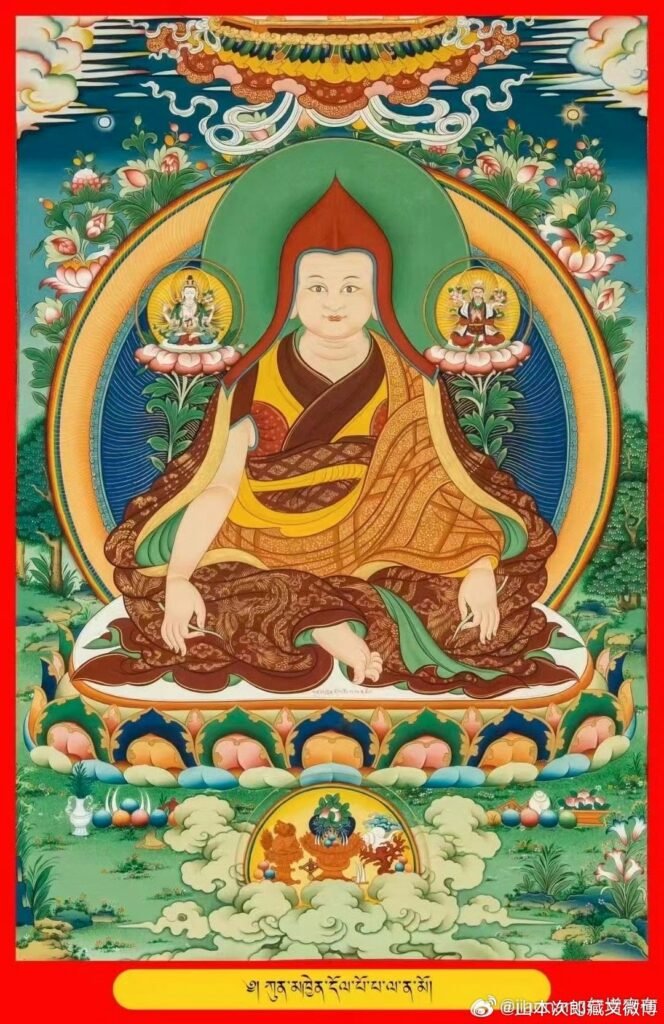Dölpopa Sherab Gyaltsen, a luminary in Tibetan Buddhism, left a remarkable legacy as he transitioned from the Sakya school to the Jonang tradition. His profound understanding of Buddhist teachings and his pivotal role in establishing Jonang’s unique Shentong philosophy solidified his position as a trailblazer in Tibetan spiritual history.
Dölpopa Sherab Gyaltsen, a revered figure in Tibetan Buddhism, was born in 1292 in the Ngari region of western Tibet, into a family devoted to the Nyingma tradition. From a young age, his profound intellect and spiritual dedication foreshadowed his role as a transformative leader in Tibetan Buddhism. His journey from a lay practitioner to a highly respected scholar and Khenpo at Sakya Monastery offers valuable insights into the depth of Tibetan Buddhist philosophy and teachings.
Early Life and Spiritual Awakening of Dölpopa Sherab Gyaltsen
Dölpopa Sherab Gyaltsen was born into the Banchen family, steeped in a rich Buddhist heritage. Guided by masters like Jidampa, he began his education with the Nyingma school’s profound teachings and Nagarjuna’s Six Treatises on the Middle Way. His natural affinity for Buddhist philosophy quickly became evident.
At age 11, he received his novice vows from Khenpo Tsultrim Nyingpo, earning the name Sherab Gyaltsen. By 16, he sought out Jetsun Kunga Zangpo, a prominent Sakya scholar, marking the start of his deep engagement with texts like the Abhisamayalankara, Madhyamakavatara, and Pramanavarttika. This early immersion in logic, debate, and meditation positioned him as a rising star in Tibetan Buddhism.

Monastic Life and Scholarly Achievements Dölpopa Sherab Gyaltsen
In 1312, at 21 years old, Dölpopa left his home to pursue advanced studies with Jetsun Kunga Zangpo. Three years later, at 24, he formally entered monastic life at Sakya Monastery, receiving full ordination from Khenchen Sonam Zangpo. His devotion to rigorous practice and intellectual mastery led to his appointment as Khenpo (head scholar) at just 25 years old.
As Khenpo, Dölpopa revolutionized monastic education. He introduced summer and winter debate sessions, fostering a dynamic intellectual environment. These assemblies became a hallmark of his legacy, attracting scholars and practitioners from across Tibet. His teachings encompassed both Sutrayana texts, such as the Prajnaparamita Sutras, and advanced Vajrayana practices, including the Kalachakra Tantra.
After departing from Sakya Monastery, Dölpopa traveled extensively across central and western Tibet. During this time, he participated in rigorous debate sessions and continued his studies under various esteemed teachers. His mastery of Buddhist doctrines across different schools earned him the honorary title Kunkhyen (All-Knowing), recognizing his unparalleled scholarship and insight.
Legacy and the Birth of Shentong Philosophy
Dölpopa Sherab Gyaltsen’s influence extended far beyond his administrative roles. He is best known for introducing the Shentong (Empty of Other) philosophical view, which emphasizes the ultimate nature of reality as luminous and unchanging. This perspective profoundly impacted Tibetan Buddhist thought, distinguishing his teachings as a significant contribution to Mahayana Buddhism.
Through his exceptional intellect and dedication, Dölpopa bridged the esoteric and exoteric traditions, inspiring generations of practitioners to pursue enlightenment. His emphasis on compassion, wisdom, and debate continues to resonate in Tibetan monasteries and beyond.
The Legacy of Dölpopa Sherab Gyaltsen: Architect of the Jonang Tradition
Dölpopa Sherab Gyaltsen, one of Tibetan Buddhism’s most influential figures, left a profound legacy through his spiritual journey and contributions to the Jonang school. His transition from the Sakya tradition to the Jonang lineage marked a pivotal chapter in his life, transforming him into a revered master and visionary leader.

Becoming a Scholar and Teacher Across Tibet
After leaving Sakya Monastery, Dölpopa traveled extensively across central and western Tibet. He participated in numerous Buddhist debate forums and continued his studies with esteemed teachers. His mastery of various Buddhist traditions earned him the title Kunkhyen, meaning “All-Knowing.” By the age of 31, his reputation as a scholar and practitioner was firmly established.
Joining the Jonang Tradition
At the age of 31, Dölpopa arrived at Jonang Monastery, where he met the esteemed Khetsun Yonten Gyatso, the monastery’s abbot. Under Khetsun’s guidance, Dölpopa received empowerments and teachings on the Six Yogas of Kalachakra. Through diligent practice, he attained profound realizations. Deeply impressed by the Jonang school’s Shentong (Other-Emptiness) philosophy, Dölpopa fully embraced its teachings and transitioned into the Jonang lineage.
By 1326, at the age of 35, Dölpopa succeeded Khetsun Yonten Gyatso as the head of Jonang Monastery. As the 18th lineage holder of the Jonang tradition, he dedicated his life to spreading its teachings and practices.

Building the Great Stupa of Jonang
One of Dölpopa’s most enduring contributions was the construction of the Gönbentun Drubchenmo, the Great Stupa of Jonang. Known as the “Stupa of Liberation at Sight,” it symbolized his vision of universal liberation. According to historical accounts, the foundation alone took years to complete, and miraculous signs, such as rainbows and unexpected streams, were reported during its construction.
This stupa remains a source of pride for Jonang practitioners, inspiring the construction of similar stupas in other regions, such as the Aba Prefecture in Sichuan.
Expanding the Jonang Legacy
Beyond the Great Stupa, Dölpopa oversaw the construction of numerous temples and stupas, including significant sites like Pumo Chuzong and Jiwapu Cliff. He also established Ongren Monastery, complete with a dedicated institute for Buddhist studies, ensuring that future generations would continue to benefit from his teachings.
As a result of his monumental contributions, Dölpopa is celebrated as the spiritual founder of the Jonang tradition. His intellectual and spiritual achievements cemented the Jonang school’s position as a significant force in Tibetan Buddhism.
